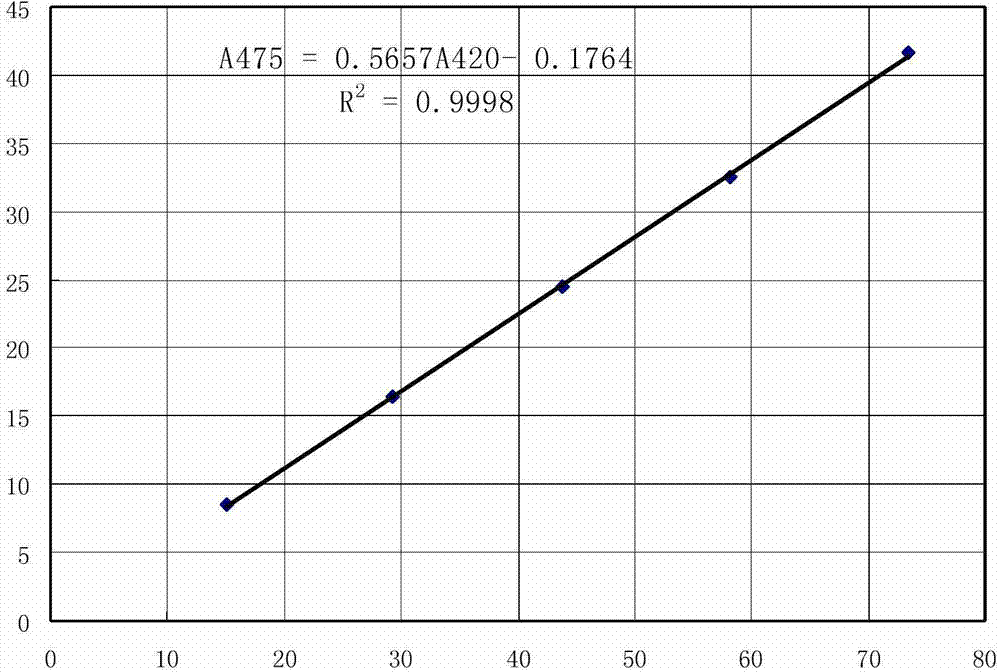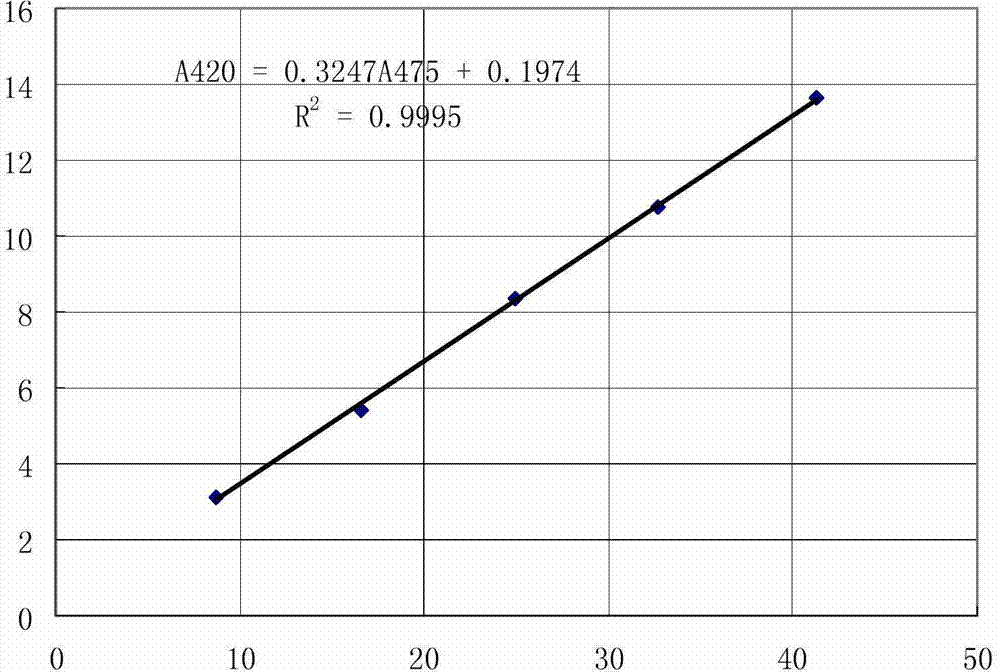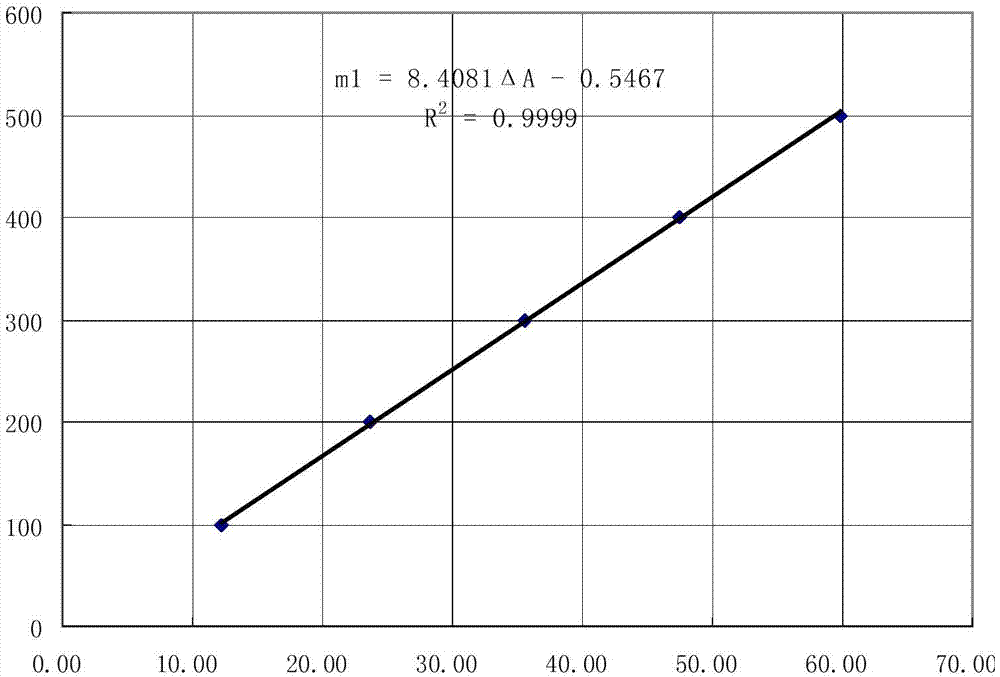Method for testing dual-wavelength of light splitting luminosity
A detection method and a spectrophotometric technology, applied in the field of spectral analysis, can solve the problem of not being able to find the satisfaction
- Summary
- Abstract
- Description
- Claims
- Application Information
AI Technical Summary
Problems solved by technology
Method used
Image
Examples
Embodiment 1
[0077] Preparation of platinum standard solution standard curve
[0078] Platinum standard solution: platinum concentration = 100μg / ml
[0079] Take 0.00, 1.00, 2.00, 3.00, 4.00, 5.00ml of platinum standard solutions respectively in a 25ml volumetric flask, add 10ml of 1mol / L stannous chloride solution, dilute to the mark with hydrochloric acid with a concentration of 1+6 , heat in a boiling water bath for 30 minutes, take it out to cool, and shake well. Use a 1cm cuvette, take the reagent blank as the reference solution, and measure the absorbance A at wavelengths of 420nm and 475nm by dual-wavelength photometry. 420 、A 475 .
[0080] Platinum working curve: Draw the working curve with the amount of platinum in m (μg) as the ordinate and the corresponding absorbance value ΔA as the abscissa. Calculate the slope K of the platinum working curve regression equation 1 and intercept b 1 .
[0081] Here, ΔA Pt =A 420 -s 2 A 475 -t 2 , coefficient s 2 and t 2 See rhodi...
Embodiment 2
[0085] Rhodium standard curve making
[0086] Rhodium standard solution: rhodium concentration = 50μg / ml
[0087] Take 0.00, 1.00, 2.00, 3.00, 4.00, 5.00ml of rhodium standard solutions respectively in a 25ml volumetric flask, add 10ml of stannous chloride solution with a concentration of 1mol / L, and dilute to the mark with hydrochloric acid with a concentration of 1+6 , heat in a boiling water bath for 30 minutes, take it out to cool, and shake well. Use a 1cm cuvette, take the reagent blank as the reference solution, and measure the absorbance A at wavelengths of 420nm and 475nm by dual-wavelength photometry. 420 、A 475 .
[0088] Rhodium working curve: draw the working curve with the amount of rhodium m (μg) as the ordinate and the corresponding absorbance value ΔA as the abscissa. Calculate the slope K of the rhodium working curve regression equation 2 and intercept b 2 .
[0089] Here, ΔA Rh =A 475 -s 1 A 420 -t 1 , coefficient s 1 and t 1 See platinum stand...
Embodiment 3
[0093] Platinum and rhodium content detection
[0094] Tin protochloride solution (1mol / L) configuration: take by weighing 22.6g tin protochloride (SnCl 2 2H 2 O), add (1+6) hydrochloric acid solution 100ml to dissolve and prepare.
[0095] Detect the test solution so that the amount of platinum and rhodium is within the measurement range, otherwise it will be diluted in proportion, take an appropriate amount of test solution and blank respectively in two 25ml volumetric flasks, add 10ml of a concentration of 1mol / L tin protochloride solution, and use a concentration of Dilute 1+6 hydrochloric acid to the mark, heat in a boiling water bath for 30 minutes, take it out to cool, and shake well. Use a 1cm cuvette, take the reagent blank as the reference solution, and measure the absorbance A at wavelengths of 420nm and 475nm respectively 420 , A475. The unit of absorbance is %.
[0096] In conjunction with embodiment 1, embodiment 2 platinum, rhodium standard curve and regres...
PUM
 Login to View More
Login to View More Abstract
Description
Claims
Application Information
 Login to View More
Login to View More - R&D
- Intellectual Property
- Life Sciences
- Materials
- Tech Scout
- Unparalleled Data Quality
- Higher Quality Content
- 60% Fewer Hallucinations
Browse by: Latest US Patents, China's latest patents, Technical Efficacy Thesaurus, Application Domain, Technology Topic, Popular Technical Reports.
© 2025 PatSnap. All rights reserved.Legal|Privacy policy|Modern Slavery Act Transparency Statement|Sitemap|About US| Contact US: help@patsnap.com



